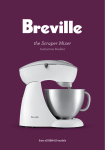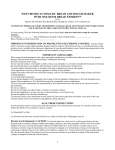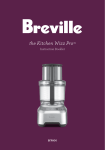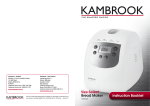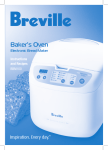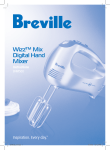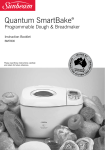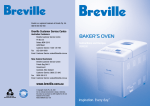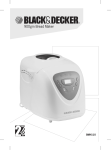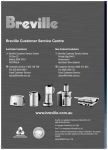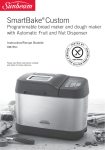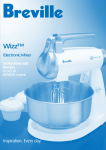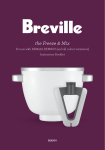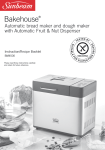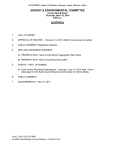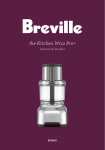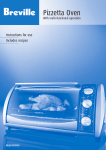Download Breville BEM800 Troubleshooting guide
Transcript
Wizz® Planetary Mixer Instruction Booklet suits all versions of BEM800 Mixers BEM800 BEM800_IB_Issue_0110.indd 1 10/12/09 9:59 AM 2 BEM800_IB_Issue_0110.indd 2 10/12/09 9:59 AM INTRODUCING THE BREVILLE PROFESSIONAL 800 COLLECTION™ Wizz® Planetary Mixer Planetary Mixing Action Patisserie Quality Results Replicating a similar mixing motion used by commercial mixers, Breville’s planetary mixing action produces patisserie and bakery quality results for evenly mixed batter, creamy icing and pliable dough. 3 BEM800_IB_Issue_0110.indd 3 10/12/09 9:59 AM Contents Congratulations on the purchase of your new Breville Professional 800 Collection™ Wizz® Planetary Mixer 5 Breville Recommends Safety First 8 Know Your Breville Wizz® Planetary Mixer 11 Before first use - Assembly and Operation of Your Wizz® Planetary Mixer 19 Care, Cleaning and Storage 21 Measuring and Weighing 25 Hints and Tips 29 The Vital Ingredients 35 Trouble Shooting Guide 37 Recipes 71 Notes 4 BEM800_IB_Issue_0110.indd 4 10/12/09 9:59 AM BREVILLE RECOMMENDS SAFETY FIRST At Breville we are very safety conscious. We design and manufacture consumer products with the safety of you, our valued customer, foremost in mind. In addition we ask that you exercise a degree of care when using any electrical appliance and adhere to the following precautions. IMPORTANT SAFEGUARDS FOR YOUR BREVILLE Wizz® Planetary Mixer • Carefully read all instructions • Do not operate the appliance before operating the Wizz® Planetary continuously on heavy loads for more Mixer for the first time and save for than 3 minutes. None of the recipes in future reference. this book are considered a heavy load. • Remove and safely discard any • Handle the bench mixer and packaging material and promotional labels before using the bench mixer for the first time. attachments with care. Never place your fingers inside the mixing bowl or near the beater, whisk or dough hook during operation. • To eliminate a choking hazard for young children, remove and safely discard the protective cover fitted to the power plug of this appliance. • Keep hands, hair, clothing, as well as, spatulas and other utensils away from moving beater, whisk or dough hook/ during operation. • Do not place the bench mixer near the edge of a bench or table during operation. Ensure the surface is level, clean and free of water and other substances. Vibration during operation may cause the appliance to move. • Should an object such as a spoon or spatula fall into the bowl while mixing, immediately ensure the Speed Control Dial is in the ‘Off’ position, turn the bench mixer off, unplug at the power outlet and remove the object. • Do not use the bench mixer on a sink drain board. • • Do not place the bench mixer on or near a hot gas or electric burner, or where it could touch a heated oven. • Always ensure the bench mixer is completely assembled before operating. Follow the instructions provided in this book. • Ensure the Speed Control Dial is in the ‘Off’ position and the bench mixer is switched off at the power outlet and the power cord is unplugged before attaching the beater, whisk or dough hook. • Do not use attachments other than those provided with the bench mixer. Use only the beater whisk and dough hook supplied with the mixer. Do not place hands in the mixing bowl unless the bench mixer is disconnected from the power outlet. Ensure the Speed Control Dial is in the ‘Off ’ position, the bench mixer is switched off and unplugged from the power outlet before removing the beater, whisk or dough hook. • Ensure the motor and beater, whisk or dough hook have completely stopped before disassembling. • Always remove the beater, whisk or dough hook from the bench mixer before cleaning. • Care should be taken when removing the food from the mixer bowl by ensuring the motor and the beater, whisk, or dough hook have completely stopped before disassembling. Ensure 5 BEM800_IB_Issue_0110.indd 5 10/12/09 9:59 AM BREVILLE RECOMMENDS SAFETY FIRST continued the Speed Control Dial is in the ‘Off” position, the appliance is switched off at the power outlet and unplugged before unlocking the mixer motor head and moving into the upright position. The beater, whisk or dough hook should be released from the mixer motor head before removing the processed food from the mixer bowl and the beater, whisk or dough hook. • Ensure the mixer motor head is locked into the horizontal (closed) position when not in use and before storing. • Always ensure the Speed Control Dial • Do not move the bench mixer whilst in operation. • Do not leave the bench mixer unattended when in use. • Do not place any part of the bench mixer in the dishwasher other than the bowl, splash guard, beater, dough hook and whisk. • Do not place any part of the bench mixer in the microwave oven. • Keep the bench mixer clean. Follow the cleaning instructions provided in this book. is in the ‘Off’ position, the power is switched off at the power outlet and the power cord is unplugged from the power outlet before attempting to move the bench mixer, before assembling or disassembling, when not in use and before cleaning or storing. 6 BEM800_IB_Issue_0110.indd 6 10/12/09 9:59 AM BREVILLE RECOMMENDS SAFETY FIRST continued IMPORTANT SAFEGUARDS FOR ALL ELECTRICAL APPLIANCES • Fully unwind the power cord before use. • Do not let the power cord hang over the edge of a bench or table, touch hot surfaces or become knotted. • To protect against electric shock do not immerse the power cord, power plug or mixer in water or any other liquid. • The appliance is not intended for use by persons (including children) with reduced physical, sensory or mental capabilities, or lack of experience and knowledge, unless they have been given supervision or instruction concerning use of the appliance by a person responsible for their safety. • Children should be supervised to ensure that they do not play with the appliance. • It is recommended to regularly inspect • Any maintenance other than cleaning should be performed at an authorised Breville Service Centre. • This appliance is for household use only. Do not use this appliance for anything other than its intended use. Do not use in moving vehicles or boats. Do not use outdoors. Misuse may cause injury. • The installation of a residual current device (safety switch) is recommended to provide additional safety protection when using electrical appliances. It is advisable that a safety switch with a rated residual operating current not exceeding 30mA be installed in the electrical circuit supplying the appliance. See your electrician for professional advice. the appliance. To avoid a hazard do not use the appliance if power cord, power plug or appliance becomes damaged in any way. Return the entire appliance to the nearest authorised Breville Service Centre for examination and/or repair. WARNING: ENSURE THE SPEED DIAL CONTROL IS IN THE ‘OFF’ POSITION THE BENCH MIXER IS SWITCHED OFF AT THE POWER OUTLET AND UNPLUGGED FROM THE POWER OUTLET BEFORE ATTACHING THE BEATER, WHISK OR DOUGH HOOK. 7 BEM800_IB_Issue_0110.indd 7 10/12/09 9:59 AM Know Your Breville Wizz® Planetary Mixer H A D K C B H G J F E A. Motor head: Powerful motor for thorough G. Pause function: rotate dial to “pause” to B. 4.7L stainless steel mixing bowl H. Breville Assist™ handles: handles on mixing results with handle C. Illuminated LED speed indicator band: displays selected mixing task D. Tilt back and lock down hinge button: the motor head tilts back and locks into position to allow easy removal of the mixing bowl and attachments E. Bowl locking recess: the bowl locking recess allows the bowl to be securely locked into place for safety and stability when the mixer is in operation temporarily stop mixing and pause the timer base and on motor head allow for easy and comfortable lifting of the mixer I. Load Sensing Technology: internal sensors detect when heavy batters are being mixed and automatically adjust to maintain the selected speed (not shown) J. Internal Cord Storage: located in the rear of the mixer. Cord pushes into the mixer base for convenient and tidy storage K. Splash guard: prevents ingredients from splattering out of the bowl F. LCD screen with count up & down timer: mixer can be set to count down according to a specified time on a recipe or set to count up to asses mixing time 8 BEM800_IB_Issue_0110.indd 8 10/12/09 10:00 AM Know Your Breville Wizz® Planetary Mixer continued L N L. Flat beater: thoroughly mixes a variety of mixtures such as cake and biscuit batter, pastries, and mashed potatoes M. Wire whisk: consistently mixes and aerates for egg whites, cream and thin batters N. Dough hook: effectively kneads heavy dough for bread and pizza O. Scraper beater: Scrapes the sides and bottom of the bowl for exceptionally thorough mixing, of cake and biscuit batter, pastry and frosting. P. Spatula: (not shown) M O About your scraper beater The Breville Scraper Beater folds ingredients and continuously scrapes down the sides and bottom of the bowl for exceptionally thorough mixing. It virtually eliminates the need to scrape the bowl by hand with a spatula and cuts mixing time up to 60%. Under-mixed batters produce poorly baked results, resulting in collapsing, unevenness of crumb, holes, low rising, streaking and course textures. the Scraper Beater will help to ensure a thoroughly mixed batter for your favourite cakes, biscuits, frosting and more. Many of the recipes provided in your instruction booklet specify the use of the Flat Beater, however, for exceptionally thorough mixing and to save time, you can use your Scraper Beater instead. 9 BEM800_IB_Issue_0110.indd 9 10/12/09 10:00 AM Before first use BEM800_IB_Issue_0110.indd 10 10/12/09 10:00 AM Assembly and Operation of Your Wizz® Planetary Mixer Assembling the mixer Before using your Breville Wizz® Planetary Mixer for the first time, remove any packaging material and promotional labels. Ensure the speed control dial is in the ‘Off’ position, the mixer is switched off at the power outlet and the power cord is unplugged. Remove the mixing bowl, beater, whisk and dough hook and wash in warm soapy water with a soft cloth. Rinse and dry thoroughly. The bowl and the attachments may be washed in the dishwasher. 3. Insert the mixing bowl into the bowl locking recess of the mixer stand and turn clockwise until the bowl locks securely into place. NOTE: When first using your Breville Wizz® Planetary Mixer, you may notice an odour coming from the motor. This is normal and will dissipate with use. Attaching the bowl 1. Place the mixer base on a level, dry surface such as a bench top. The mixer motor head should be in the horizontal (closed) position. Raise the mixer motor head by depressing the tilt back hinge button. NOTE: To remove or insert the mixing bowl, the mixer motor head must be raised and locked into the open position. Attaching the scraper beater to the mixer motor head 1. Ensure the mixer motor head is in 2. Lift the mixer motor head up until it tilts back and locks into the open position. the raised/open position. Align the groove in the top of the Scraper Beater with the locking pin on the spindle extending down from the mixer motor head. 2. Push the scraper beater upwards and turn clockwise until it locks securely onto the locking pin on the spindle (see Fig. 1). 11 BEM800_IB_Issue_0110.indd 11 10/12/09 10:00 AM Assembly and Operation of Your Wizz® Planetary Mixer continued Fig. 1 3. Lower the mixer motor head by depressing the tilt back button and gently pushing the mixer motor head down until it locks into the horizontal (closed) position (see Fig. 2). 2. Press the beater, dough hook or whisk upwards and turn clockwise until it locks securely onto the locking pin on the spindle. Fig. 2 4. The splash guard can now be assembled if required. Slide the main ring into position on top of bowl, then assemble the pour spout. Attaching the beater, dough hook or whisk 1. Ensure the mixer motor head is in the raised open position. Align the groove in the top of the beater, dough hook or whisk with the locking pin on the spindle extending down from the mixer motor head. Note: When ingredients are in the mixing bowl, the scraper beater may make a slight noise as it scrapes the sides and bottom of the bowl. This is normal and should not cause concern. Do not turn the mixer on with the scraper beater in place if the mixing bowl is empty. This will cause the scraper beater to make a loud noise as it scrapes the bowl. 3. Lower the mixer motor head by depressing the tilt back hinge button and pushing the mixer motor head down until it locks into the horizontal (closed) position. 4. Splash guard can now be assembled if required. Slide main ring into position on top of bowl, then assemble pour spout. Operating the mixer Planetary Mixing Action By replicating a similar mixing action used by commercial mixers in bakeries and patisseries, The Breville Wizz® Planetary Mixer head rotates around the bowl whilst rotating the beater in the opposite direction. This ensures a superior and thorough mixing result without the need for a rotating bowl. 12 BEM800_IB_Issue_0110.indd 12 10/12/09 10:00 AM Assembly and Operation of Your Wizz® Planetary Mixer continued 1. Ensure the speed control dial is set to the ‘Off’ position, plug the cord into a 220-240v power outlet and switch the power ‘ON’ at the power outlet. The illuminated LED speed indicator band will flash and the Count Up/Down timer will display “0:00.” The mixer is now ready to be used. NOTE: If the mixer has not been used for 3 minutes it will automatically go to a power saving “stand by mode.” The mixer can be left in stand by until the ingredients in the bowl are ready to be mixed. To exit stand by and begin mixing, turn the dial to the selected speed or press one of the ‘Count Up/ Down timer buttons. 2. Add ingredients to the mixing bowl as indicated in the recipe. Always begin mixing by selecting a low speed setting on the speed control dial. This will prevent ingredients splattering. Increase the speed as suited to the mixing task. The speed setting can be adjusted during operation by moving the dial clockwise for the main mixing settings. Use the mixing guide in this booklet as a reference. If necessary, stop the mixer during operation and scrape any food mixture down the sides of the mixing bowl with a spatula. NOTE: Always turn the Breville Wizz® Planetary Mixer off if you need to scrape the bowl during use, and then switch back on and continue mixing. The count-up timer The count-up timer is especially useful to gauge mixing time or when recipe does not specify the mixing time. You can monitor the time it takes to thoroughly mix the ingredients, so that the next time you mix the same ingredients you can set the count-down timer for the specific time. The count-up timer will automatically begin counting up as soon as the dial is rotated from ‘Off’ to one of the speeds. When the dial is turned to "Pause" the total time will be displayed on the LCD and will flash. When the dial is turned to "OFF", the LCD display will reset back to "0:00". 13 BEM800_IB_Issue_0110.indd 13 10/12/09 10:00 AM Assembly and Operation of Your Wizz® Planetary Mixer continued The count-down timer The count-down timer is especially useful for any recipe that specifies the length of time ingredients should be mixed. For example, if a recipe reads, “beat for 3 minutes,” you can set the count-down timer to 3 minutes by pressing the up/down arrows. After 3 minutes of mixing, an alarm will sound and the motor will automatically turn off. The count-down timer will flash “OFF”. The control dial must to be rotated to the “Off” position to reset the timer and to continue mixing. To set the count down timer, press the up or down arrows until the desired mixing time is displayed on the LCD screen. NOTE: Press and hold the arrows down to scroll through the timer setting more quickly. Rotate the dial clockwise to select the desired speed and to begin mixing. When the timer has finished counting down, “0:00” will flash on the LCD screen and a beep will sound to notify you that the time has expired. The mixer will automatically turn the motor off. The control dial must be rotated to the 'OFF' position to reset the timer and to continue mixing. NOTE: The maximum time displayed on the timer is 9:59 (nine minutes, fifty-nine seconds). The mixer will automatically switch Off at 9 minutes 59 seconds. The control dial needs to be rotated to the “Off” position to reset the timer and to continue mixing. Pause Mode While mixing, at any stage, you can rotate the control dial to the “pause” setting. This will turn the motor off and “pause” the timer. This enables you to assess the mixing progress or add additional ingredients without effecting the timer. For example, if you are mixing using the ‘count-up timer’ mode, you can rotate the control dial from one of the mixing speeds to “pause”. The mixer motor will stop and the timer will “pause”. Once ready, you can rotate the dial back to one of the mixing speeds, the timer will continue to countup from the exact time it was paused. Alternatively, if you have turned the mixer to “pause” you can then reset the timer to 0:00 by rotating the dial to “Off” position. If using the “pause” function in ‘countdown timer’ mode, you can suspend the timer at any stage during the count-down process by rotating the control dial to the “pause” setting. To continue mixing in the ‘count-down timer’ mode, simply rotate the dial back into one of the mixing speeds or alternatively to the “Off” position to reset the timer to 0:00. Thermo cut-off – Temperature Overload The mixer is equipped with a self-resetting safety device which safeguards against overheating the motor with excessive loads. If overheating occurs, the mixer will automatically activate the overheating protection device and the motor will switch 14 BEM800_IB_Issue_0110.indd 14 10/12/09 10:00 AM Assembly and Operation of Your Wizz® Planetary Mixer continued itself off. Should the mixer go into this mode, the LED indicator band will flash and the error message “E2” will flash on the LCD screen and the buzzer will “beep” 3 times. the appliance off at the power outlet and unplug the cord. Remove some of the ingredients in the mixing bowl and then restart the mixer. Disassembling the mixer 1. When mixing is complete, turn the speed control dial to the ‘Off/Stand by’ position, switch the appliance off at the power outlet and unplug the cord. 2. Remove splash guard if assembled. Separate pour spout then slide main ring out of position. If this error occurs, turn the speed control dial to the ‘Off’ position, switch the appliance off at the power outlet and unplug the cord. Wait at least 15 minutes before restarting the mixer. Electronic Protection Cutoff – Current Overload The mixer is equipped with an electric protection cutoff and will automatically stop operating if the motor is stalled or overloaded. This is normally a result of excessive ingredients being processed at one time. Should the mixer go into this mode, the LED indicator band will flash and the error message “E1” will flash on the LCD screen and the buzzer will “beep” 3 times. 3. Raise the mixer motor head by depressing the tilt back button and lift the mixer motor head up until it tilts back and locks into the open position. 4. Remove the beater/dough hook/whisk attachment by holding the mixer motor head and pressing the attachment upwards on the spindle. Turn the attachment anticlockwise to release it from the pin on the spindle. 5. Use a soft plastic spatula to remove mixture from the beater, dough hook or whisk attachment. NOTE: When lowering or lifting the mixer, always support the motor head with your other hand to prevent from free-falling. 6. Remove the mixing bowl from the indented bowl locking recess of the mixer Base and turn anti-clockwise until the bowl releases. Use a soft plastic spatula to remove mixture from the mixing bowl. 7. Lower the mixer motor head by If this error occurs, turn the speed control dial to the ‘Off” position, switch depressing the tilt back hinge button and pushing the mixer motor head down until it locks into the horizontal (closed) position. 15 BEM800_IB_Issue_0110.indd 15 10/12/09 10:00 AM Assembly and Operation of Your Wizz® Planetary Mixer continued WARNING: AVOID CONTACT WITH BEATER/DOUGH HOOK/WHISK DURING OPERATION. KEEP HANDS, HAIR, CLOTHING, SPATULAS AND OTHER UTENSILS AWAY FROM BEATER/DOUGH HOOK/WHISK TO PREVENT PERSONAL INJURY OR DAMAGE TO THE MIXER. 16 BEM800_IB_Issue_0110.indd 16 10/12/09 10:00 AM 17 BEM800_IB_Issue_0110.indd 17 10/12/09 10:00 AM Care, Cleaning and Storage BEM800_IB_Issue_0110.indd 18 10/12/09 10:00 AM Care, Cleaning and Storage Cleaning after use Scraper Beater 1. Always ensure the speed control dial 1. Wash the scraper beater in warm, is in the ‘Off’ position, the mixer is switched off at the power outlet and the power cord is unplugged. 2. Remove the beater, dough hook or whisk attachment and mixing bowl from the mixer. Follow instructions in the ‘Assembly and operation’ section of this booklet 3. Wipe the mixer motor head and mixer stand with a soft, damp cloth then dry thoroughly. Wipe any excess food particles from the power cord. Wash the bowl, beater, dough hook, and whisk in warm soapy water with a soft cloth or they can be washed in the dishwasher. Rinse and dry thoroughly. NOTE: Do not use abrasive scouring pads or cleaners when cleaning the mixing bowl, flat beater, dough hook or whisk as these may scratch the surface. Also ensure that the attachments are not soaked in water for extended periods of time, for example several hours or overnight, as this may damage the finish. NOTE: Do not wash or immerse the mixer motor head and mixer base in water or any other liquid. Clean with a soft, damp cloth and dry thoroughly. Do not allow water or any liquid to enter the gear system as damage may result. soapy water using a soft cloth or a soft bristled brush. Rinse and dry thoroughly. 2. The Scraper Beater can also be washed in the dishwasher (top shelf only). 3. A small bottle brush can be used to clean inside the neck of the Scraper Beater if needed. Storage Your Breville Wizz® Planetary Mixer should be kept in a convenient position on your kitchen bench top or in an accessible cupboard. Always ensure the speed control dial is in the ‘Off’ position, the mixer is switched off at the power point and the power cord is unplugged. Store the mixing bowl in the bowl locking recess in the mixer Base. Place the attachments inside the mixing bowl and lower the mixer motor head into the horizontal (closed) position. The motor head cannot be taken off the base for any purpose. 19 BEM800_IB_Issue_0110.indd 19 10/12/09 10:00 AM Measuring and Weighing BEM800_IB_Issue_0110.indd 20 10/12/09 10:00 AM Measuring and Weighing Care should be taken when weighing and measuring ingredients to achieve accuracy and consistency. Australian Metric Measurements ml 1 teaspoon 5 1 tablespoon 20 1 cup 250 NEW ZEALAND Metric Measurements ml 1 teaspoon 5 1 tablespoon 15 1 cup 250 Recipes in this instruction book have been developed using Australian metric weights and measurements. The New Zealand tablespoon is 5ml less than the Australian tablespoon, so care should be taken when measuring ingredients to compensate for the variance. For example, 1 Australian tablespoon = 1 New Zealand tablespoon + 1 New Zealand teaspoon. It is important to note that New Zealand ingredients, especially flour and yeast, can differ from Australian equivalents. In the Vital Ingredients section of this booklet, suitable New Zealand products have been listed. We suggest these New Zealand products be substituted for the Australian products in the Recipe Section. Metric weighing scales For consistent results it is recommended that a Breville kitchen scale (for details visit www.breville.com.au) be used to weigh larger quantities as they provide greater accuracy than measuring cups. Tare (zero) the scales with the container in position then spoon or pour ingredients in until the desired weight is achieved. Metric measuring cups and spoons If using graduated metric measuring cups, it is important to spoon the dry ingredients loosely into the required cup. Do not tap the cup on the bench or pack the ingredients into the cup unless otherwise directed. Level the top of the cup with a knife. When using graduated metric measuring spoons, level the top of the spoon with a straight edged knife or spatula. Metric liquid measuring jugs If using a graduated, metric measuring jug, place jug on a flat surface and check for accuracy at eye level. NOTE: In general, water weighs the same in grams as it measures in millilitres. 21 BEM800_IB_Issue_0110.indd 21 10/12/09 10:00 AM Measuring and Weighing continued The following oven temperature settings are included as a guide. These settings may need to be adjusted to suit the individual oven. Thermostat Settings Description of oven temperatures °C Electric °F °C Gas °F Gas Mark Very slow 120 250 120 250 1 Slow 150 300 150 300 2 Moderately slow 170 325 160 325 3 Moderate 180 350 180 350 4 Moderately hot 200 400 190 375 5 Hot 220 425 200 400 6 Very hot 230 450 230 450 7 NOTE: If using fan forced ovens be sure to turn the temperature down by 15-20°C. Also check recipes at the back of this book. 22 BEM800_IB_Issue_0110.indd 22 10/12/09 10:00 AM 23 BEM800_IB_Issue_0110.indd 23 10/12/09 10:00 AM Hint and Tips BEM800_IB_Issue_0110.indd 24 10/12/09 10:00 AM Hints and tips For better bread making amount of flour and water should form into a smooth, round ball that is damp to the touch but not sticky. • Do check the ingredients and read the recipe before starting to bake. • Do measure ingredients accurately • When hand-shaping dough for rolls, weigh each piece of dough for more evenly sized rolls. — weighed measurements are more accurate than volume measurements. • Do use bread flour unless recipe states otherwise. • Do check use-by-dates on ingredients. Sponging yeast • Instant active dried yeast is used in the recipes in this book however fresh or compressed yeast can be substituted, if required, for specific flavour or religious dietary requirements. • Do add ingredients in the order stated in the recipe. • Do store opened ingredients in airtight containers. • Fresh or compressed yeast needs to be ‘sponged’ (fermentation started) before adding to the other ingredients. • Do use ingredients at room temperature. • Don’t use flour that contains a protein • To substitute, use three times the amount of fresh or compressed yeast for the amount of dry yeast in a recipe. level of less than 11%. • Don’t use tableware cups, jugs or spoons for measuring. • To sponge the yeast: Place the quantity of fresh compressed yeast in the quantity of (warmed) water from the recipe together with 1 teaspoon sugar and 1 teaspoon flour into a clean glass bowl, stir to dissolve and cover with plastic wrap. Allow to stand in a warm area (30ºC) for about 30 minutes or until the mixture starts to bubble and froth. This mixture should be used without delay. • Don’t use hot water or liquids. • Don’t use self-raising flour to make yeasted bread unless recipe states otherwise. • If you live in a high altitude area above 900m you will probably need to alter the yeast quantity in the bread recipe. The higher the altitude, the lower the air pressure and the faster the dough will rise. Try reducing the yeast by ¼ teaspoon. • If the weather is hot and humid, reduce the yeast by ¼ teaspoon to avoid over rising of the dough. • Flour properties can alter on a seasonal or storage basis, so it may be necessary to adjust the water and flour ratio. If the dough is too sticky, add extra flour 1 tablespoon at a time if the dough is too dry add extra water 1 teaspoon at a time. A few minutes is needed for these extra ingredients to be absorbed. Dough with the correct Warm area for rising • Yeast, either when sponging or in the dough, requires warmth to rise. • To create a ‘warm area’ for dough to rise, place baking tray over a bowl of fairly warm water, place prepared dough item on baking tray, cover loosely with lightly greased thicker-style plastic wrap or a tea towel. Ensure kitchen is warm and free of draughts. Allow the dough to rise until doubled in size. 25 BEM800_IB_Issue_0110.indd 25 10/12/09 10:00 AM hints and tips continued For better baking • Check the ingredients and read the recipe before starting to bake. • Weigh and measure ingredients correctly. • Variations may occur in raw ingredients used so adjust other ingredients and baking times if required. • Preheat oven before starting recipe preparation, this will ensure the correct temperature is achieved before baking starts. • Temperatures and cooking times may vary with some ovens so adjust accordingly. If using a fan forced oven reduce the temperatures in the recipes by 10ºC. • When mixing, start the mixer at a lower speed then gradually increase to the recommended speed in the recipe especially when adding dry ingredients. • When using smaller quantities turn off the mixer from time to time and scrape the bowl with a spatula. • Ensure wire whisk and mixing bowl are clean and free of fats when whipping egg whites as these will impede aeration. • Instead of greasing baking pans or trays, line with baking paper where appropriate. However, a little light greasing in pans will keep the paper in place. • Avoid stretching pastry when rolling out as it will shrink when baking. Use light, even strokes in one direction and avoid pressing down hard on the rolling pin. Where possible, rest pastry in the refrigerator before baking. • Eggs should be at room temperature to give better volume when whipping • Break eggs individually into another container before adding to other ingredients to avoid potential spoilage. • Separate egg whites carefully to avoid inclusion of egg yolks. Egg yolks contain fat and will prevent successful whipping of egg whites. • Rinse beaten egg residue from whisk, beater and mixing bowl or other utensils with cold water immediately after use. Using hot water will set the egg and make removal difficult. • Test if cakes are cooked at the end of baking time by touching the top lightly, the cake will spring back if cooked. A fine skewer can also be inserted carefully into the centre of the cake, if it comes out clean the cake is cooked. • For crisper results when baking biscuits, remove the baking trays from the oven and place directly onto wire racks. Move the biscuits slightly away from their baked position on the trays and cool completely before removing. • Pre warm a measuring spoon in hot water for easy measuring of golden syrup or honey. • Butter should be softened at room temperature to make creaming butter and sugar easier. • Keep surfaces and ingredients chilled when making, handling or rolling out pastry. Butter for pastry making should be kept refrigerated. 26 BEM800_IB_Issue_0110.indd 26 10/12/09 10:00 AM 27 BEM800_IB_Issue_0110.indd 27 10/12/09 10:00 AM The Vital Ingredients BEM800_IB_Issue_0110.indd 28 10/12/09 10:00 AM THE VITAL INGREDIENTS For bread making Flour is the most important ingredient used for bread making. It provides food for the yeast and gives structure to the loaf. When mixed with liquid, the protein in the flour starts to form gluten. Gluten is a network of elastic strands that interlock to trap the gases produced by yeast. This process increases as the dough continues kneading and provides the structure required to produce the weight and shape of the baked bread. White wheat flour sold as baker’s, bread or plain flour may be used. Plain flour is most readily available, however, best results are obtained with flour at least 11% protein content. For this reason, the recipes in this book requiring bread flour have been made using flour with 11% protein content. This is normally indicated on the packaging. Do not sift the flour or use self-raising flour for bread making unless indicated in the recipe. NOTE: When using a low-protein, plain, stone ground or wholemeal flour the quality of the bread can be improved by adding gluten flour. Baker’s or Bread Flour There are several brands of bread or bakers flour available nationally at larger supermarkets.. It is a high protein, white bread flour, with 11% protein. NOTE: New Zealand only: ‘Elfin High Grade White Flour’ or ‘Champion High Grade Flour’. These are high protein, white bread flours containing 12% protein. Wholemeal wheat flour contains the bran, germ and flour of the wheat grain. Although breads baked with this type of flour will be higher in fibre, the loaf may be heavier in texture. Lighter textured bread can be achieved by replacing 1 cup of wholemeal flour with white bread flour. Rye flour, popular for bread making, is low in protein so it is essential to combine rye flour with bread flour to make the bread rise successfully. Rye flour is traditionally used to make the heavy, dense Pumpernickel and Black Breads. Gluten flour is made by extracting the gluten portion from the wheat grain. Adding gluten flour can improve the structure and quality of bread when using low-protein, plain, stone ground and whole meal flour. Bread mixes contain flour, sugar, milk, salt, oil and other ingredients such as bread improver. Usually only the addition of water and yeast is required. Bread mix brands such as ‘Laucke’, ‘Kitchen Collection’, ‘Defiance’, and ‘Lowan’ are available nationally from major supermarkets. For recipe information on these and other brands of bread mix contact the manufacturer listed on the package. NOTE: New Zealand only: Bread mix brands such as ‘Elfin’ are available. Bread improvers are available nationally in supermarkets and health food stores. The ingredients in a bread improver are usually a food acid such as ascorbic acid (Vitamin C) and other enzymes (amylases) extracted from wheat flours. Adding a bread improver will help strengthen the dough resulting in a loaf that is higher in volume, softer in texture, more stable and has improved shelf life qualities. A simple bread improver can be a crushed unflavoured vitamin C tablet added to the dry ingredients. 29 BEM800_IB_Issue_0110.indd 29 10/12/09 10:00 AM THE VITAL INGREDIENTS continued Sugar provides sweetness and flavour, browns the crust and produces food for the yeast. White sugar, brown sugar, honey and golden syrup are all suitable to use. When using honey or golden syrup it must be counted as additional liquid. We have successfully tested granular ‘Splenda’ brand low calorie sweetener as a sugar substitute. NOTE: New Zealand only: Sugar can be reduced for more improved results. Powdered milk and milk products enhance the flavour and increase the nutritional value of bread. Powdered milk is convenient and easy to use (store in an airtight container in the refrigerator). Low fat or skim milk powder can be used with good results. Soy milk powder can also be used but produces a denser loaf. Fresh milk should not be substituted unless stated in the recipe. Salt is an important ingredient in bread making. In the dough, salt increases water absorption, improves kneading, strengthens the gluten development and controls fermentation of the yeast which results in improved loaf shape, crumb structure, crust colour, flavour and keeping qualities. As salt inhibits the rising of bread be accurate when measuring. NOTE: New Zealand only: Salt can be reduced for more improved results. Fat adds flavour and retains the moisture. Vegetable oils such as safflower, sunflower, canola, etc. can be used. Butter or margarine can be substituted for oil in recipes but may give a yellow coloured crumb. Yeast is used as the raising agent for the breads and requires liquid, sugar and warmth to grow and rise. Dried yeast has been used in the recipes in this instruction book where appropriate. Before using dried yeast always check the use by date, as stale yeast will prevent the bread from rising. ‘Tandaco’ brand yeast (available nationally in most supermarkets) was used in the development of all yeasted recipes contained in this book. Smaller packets of bread mix usually contain sachets of yeast. Larger bulk bags of bread mix usually do not include the yeast sachets, however the corresponding brand of yeast may be purchased separately. Some bulk and imported yeasts are more active, therefore it is recommended to use less of these yeasts. Yeast may also be more active in hot weather. For information on other brands of yeast relating to quantities contact the manufacturer listed on the package. NOTE: New Zealand only: We recommend the use of ‘Elfin’ brand yeast. Rapid rise yeast is a mixture of yeast and bread improver. Brands will vary in strength. If wishing to substitute for yeast in a recipe, omit the bread improver. Rapid Rise yeasts should not be used with Bread Mix as bread improver is already included. NOTE: New Zealand only: ‘Edmonds Surebake Yeast’ is the most readily available yeast product in New Zealand. Water from the tap is used in all bread recipes. If using water in cold climates or from the refrigerator, allow water to come to room temperature. Extremes of hot or cold water will prevent the yeast activating. 30 BEM800_IB_Issue_0110.indd 30 10/12/09 10:00 AM THE VITAL INGREDIENTS continued Eggs can be used in some bread recipes and provide liquid, aid rising and increase the nutritional value of the bread. They add flavour and softness to the crumb and are usually used in sweeter types of bread. Other ingredients such as fruit, nuts, chocolate chips, etc., required to remain whole in the baked bread, should be suspended in the dough. These ingredients should be gradually added during the kneading and before the dough rises for the first time. For more information about bread mixes please contact the relevant number listed below. Or refer to contact details on the packaging of the bread. Laucke (08) 8536 5555 Defiance 1800 628 883 Kitchen Collection 1800 649 494 Lowan Wholefoods 1800 355 718 Elfin (New Zealand only) 0800 110 800 For cake and pastry making Flour, such as plain, self raising and wholemeal, used for cake and pastry making should be lower in protein (gluten) than flour used for bread making. Plain flour has a lower protein (gluten) content and gives baked products, such as cakes, muffins, pastries, scones and pancakes, a softer texture. Self–raising flour is a blend of plain flour and raising agents such as baking powder. Self raising flour can be used in recipes to replace plain flour and baking powder. To make 1 cup self-raising flour sift together 1 cup plain flour and 2 teaspoons baking powder. Wholemeal flour contains more parts of the whole wheat grain — flour, bran and wheat germ — and can be used in muffins, breads and pie cases but will have a denser texture. For more information about bread flour please contact the relevant telephone number listed below or refer to contact details on the package. Laucke (08) 8536 5555 Defiance Baker’s Flour 1800 628 883 Elfin/Champion High Grade Plain Flour (New Zealand only) 0800 110 800 For more information about gluten flour and bread improver please contact: Lowan Wholefoods 1800 355 718 31 BEM800_IB_Issue_0110.indd 31 10/12/09 10:00 AM THE VITAL INGREDIENTS continued Speed setting Attachment Mixing task For Kneading/Folding kneading/folding Bread dough Creaming/Beating beating/creaming or light mixing packet cake mixes, muffins. Creaming butter and sugar, cream cheese, heavy batters Whipping/Aerating whipping/aerating cream, egg white/ meringues, marshmallow Corn flour is made from maize (corn) and is used in some baked products to give a finer texture and can also be used as a starch to thicken sauces and desserts. Rice flour is derived from rice and is used to give a finer texture in baked products such as shortbread biscuits. Baking powder is a mixture of cream of tartar and bicarbonate of soda and is used as a raising agent in baking. Bicarbonate of soda also known as baking soda is an ingredient in baking powder and can be used as an additional raising agent or to darken some baked products. Butter will give particular flavour and soft texture to baked products. Margarine can replace butter to give a similar result. Oil can be used in some baking to replace butter but will give texture and flavour differences — use only ¾ of the amount of butter. Eggs should be at room temperature to give better volume when making cakes and sponges. Standard 60g eggs were used in the recipes. Sugar (white crystal sugar) is used to give flavour, texture and colour to baked products. Caster sugar is often used in baking as it is easier to dissolve when creaming butter and sugar. Brown sugar is also easy to dissolve and can be used to give a different flavour and texture. The large crystals of raw sugar are slower to dissolve and can be suitable for baked products such as muffins. Using the scraper beater The Scraper Beater can be used for a variety of mixing tasks. These include creaming butter and sugar, pastry, cake and biscuit batter, thin batter, icing and frosting. Due to the efficient mixing action of the Scraper Beater, the mixing time of many recipes will be reduced. Refer to the chart below for approximate mixing times for common mixing tasks. Milk should be full cream unless specified. Light, low fat or skim milk can be used but will give texture and flavour differences. 32 BEM800_IB_Issue_0110.indd 32 10/12/09 10:00 AM THE VITAL INGREDIENTS continued mixture mixing task approx. mixing time Butter & Sugar Creaming 3-4 minutes (or until mixture is light and creamy) Pastry Combining/rubbing butter & flour for pastry or crumble 50-60 seconds (or until ingredients resemble course bredcrumbs The addition of liquid ingredients to form pastry dough 20-30 seconds (or until ingredients have just come together) Cake, muffin beater Incorporating wet and dry ingredients 30-40 seconds (or until all ingredients are combined) Biscuits & cookie mixtures Incorporating wet and dry ingredients 30-40 seconds (or until all ingredients are well combined) Thin/light batters (ie. Pancakes) Incorporating wet and dry ingredients 40-50 seconds (or until all icing is smooth) Icing Incorporating wet and dry ingredients 30-40 seconds (or until all ingredients are combined) Frosting Creaming butter 1-2 minutes (or until butter is smooth & creamy) Combining icing sugar, butter & liquid ingredients 50-60 seconds (or until mixture is light and fluffy) NOTE: Longer mixing times may be required for larger or double quantities. Do not use the Scraper Beater for mixing heavy dough (bread, pizza etc) or whisking egg whites. The above timings are to be used as a guide only. When adding flour to the mixing bowl, always use splash guard and ensure the mixer is on the folding/kneading setting. This will prevent flour from escaping the bowl. Fig. 3 TIP: The Scraper Beater can also be used as a spatula when removing cake, biscuits or other mixtures form the mixing bowl (see Fig. 3). 33 BEM800_IB_Issue_0110.indd 33 10/12/09 10:00 AM THE VITAL INGREDIENTS continued Issue Choice of attachments Speed settings Tip Use the beater for all mixing tasks. Use the whisk for all whipping or aeration tasks. Use dough hook only for kneading bread dough. Use the mixing guide to select a suitable mixing speed when preparing recipes. Begin mixing at lowest speed then increase to higher speed to prevent splattering. Mixing Mix for the recommended time in the recipe — avoid over mixing. Should an object such as a spoon or spatula fall into the bowl while mixing, immediately turn the mixer off, unplug at the power outlet and remove the object. Egg white Be sure the whisk and bowl are completely clean and dry before use — a small amount of fat or egg yolk will affect whipping performance. Bread dough Add liquid ingredients to the dry ingredients. Use Kneeding/Folding setting to knead ingredients into a dough ball. DO NOT place hands near dough hook when mixer is operating. 34 BEM800_IB_Issue_0110.indd 34 10/12/09 10:00 AM 35 BEM800_IB_Issue_0110.indd 35 10/12/09 10:00 AM Troubleshooting BEM800_IB_Issue_0110.indd 36 10/12/09 10:00 AM TROUBLESHOOTING GUIDE POSSIBLE PROBLEM EASY SOLUTION • Always ensure the speed control dial is in the “Off” position before start. Machine will not work when switched “ON” • The “thermo cut-off – Temperature Overload” Cannot set the time on the Count-down timer. • Always ensure the speed control dial is in the “Off” protection device has not been activated automatically, allow more time for the motor to cool down. position before trying to set the count-down time. • The mixer has been stressed by overloading or Mixer suddenly switches off during mixing stalling. The mixer will automatically activate the overload protection button and the unit will switch itself off. When this happens it is recommended that the unit is switched off at the power outlet and unplugged. The safety devices will the be reset and the Breville Wizz planetary mixer is ready to use again. • The mixer will automatically stop operating if the motor “E1” error message is flashing on the count-up/ down timer display is stalled. If this occurs, the ‘E1’ error message will flash on the count-up/down timer display. This is an electronic safety feature. This is normally a result of too much ingredients being processed at one time. Try removing some of the ingredients from the bowl. To continue mixing, turn the speed control dial to the off position and unplug the mixer from the power outlet. Then plug the mixer into the power outlet and use as normal. • This may indicate that the motor has been stressed “E2” error message is flashing on the count-up/ down timer display. by overheating with excessive load. The mixer is fitted with a self-resetting safety device which safeguards against overheating on the motor with excessive loads. If overheating occurs, the mixer will automatically activate the overheating protection device and the motor will switch itself off. When the overheating protection is activated, unplug the mixer from the power outlet for at least 15 minutes to allow the unit to cool. Turn the speed control dial to the “Off” position then plug the mixer into the power outlet and use as normal. • When ingredients are in the mixing bowl, the scraper Noise is heard when scraper beater is mixing beater may make a slight noise as it scrapes the sides and bottom of the bowl. This is normal and should not cause concern. Do not turn the mixer on with the scraper beater in place if the mixing bowl is empty. This will cause the scraper beater to make a loud noise as it scrapes the bowl. 37 BEM800_IB_Issue_0110.indd 37 10/12/09 10:00 AM Recipes BEM800_IB_Issue_0110.indd 38 10/12/09 10:00 AM BISCUITS AND SLICES BUTTER BISCUITS ORANGE BISCUITS Makes 40 1 quantity Butter Biscuit mixture 1 tablespoon finely grated orange rind 125g butter, softened ¾ cup caster sugar 1 teaspoon vanilla essence 1 x 60g egg 2 cups (300g) plain flour 1 teaspoon baking powder 1. Pre-heat oven to 180ºC. 2. Assemble Mixer using scraper beater. 3. Using Beating/Creaming setting, cream butter and sugar until light and creamy, about 3 minutes. 4. Add vanilla essence and egg, mix until light and fluffy, about 30 to 40 seconds 5. Sift flour and baking powder together. 6. Using Folding/Kneading setting, gradually add sifted ingredients into the creamed mixture, mix until just combined, about 30 to 40 seconds. Do not over mix. 7. Roll heaped teaspoons of biscuit mixture into balls and place evenly onto lightly greased baking trays. Allow space for spreading. Flatten balls slightly with a lightly floured fork. 8. Bake for 12-15 minutes or until cooked and pale golden. 9. Remove biscuits from tray and cool on a wire rack. Step 2: (Omit vanilla essence) add sugar, orange rind and egg, cream until light and fluffy. LEMON BISCUITS 1 quantity Butter Biscuit mixture 3 teaspoons finely grated lemon rind Step 2: (Omit vanilla essence) add sugar, lemon rind and egg, cream until light and fluffy. SPICE BISCUITS 1 quantity Butter Biscuit mixture 1 tablespoon ground cinnamon 1 teaspoon nutmeg Step 4: Sift flour, baking powder and spices together. SULTANA BISCUITS 1 quantity Butter biscuit mixture ½ cup sultanas Step 5: Gradually add sifted ingredients into the creamed mixture until just combined. Fold in sultanas. Do not over mix. VARIATIONS: CHOCOLATE BISCUITS 1 quantity Butter Biscuit mixture 2 tablespoons cocoa Step 4: Sift flour, baking powder and cocoa together. 39 BEM800_IB_Issue_0110.indd 39 10/12/09 10:00 AM BISCUITS AND SLICES continued DOUBLE CHOC CHIP COOKIES GINGERBREAD BISCUITS Makes 50 Makes 20 180g butter, chopped 150g dark chocolate, chopped 1 ½ cups (225g) plain flour ¾ cup/300g cocoa 1½ cups brown sugar 3 x 60g eggs, lightly beaten 1½ cups dark choc bits 125g butter, softened 1 ⁄3 cup brown sugar 1 ⁄3 cup golden syrup 1 x 60g egg, lightly beaten 2¼ cups (340g) plain flour 1 tablespoon ground ginger 1 teaspoon baking powder 1 teaspoon bicarbonate of soda Extra flour, for kneading 1. Pre-heat oven to 170ºC. 2. Melt butter and dark chocolate in a small saucepan over a low heat, stirring constantly until smooth. Allow to cool slightly, mixture should still be warm. 3. Assemble Mixer using scraper beater. 4. Using Folding/ kneading setting, mix plain flour, cocoa and brown sugar until combined, about 30 to 40 seconds. 5. Using Folding/Kneading setting, gradually add the butter mixture and eggs, mix until well combined, about 1 minute. 6. Add choc bits and mix until just combined. 7. Spoon tablespoons of mixture onto lightly greased and baking paper lined baking trays. Allow 3cm spaces for spreading. 8. Bake for 15-20 minutes or until firm on top. 9. Cool biscuits on trays for 5 minutes before transferring to wire rack. VARIATIONS: • Replace ½ cup dark choc bits with ½ cup white choc bits. • Replace ½ cup dark choc bits with ½ cup chopped macadamia nuts. • Make chunky double choc chip cookies by baking 2 tablespoons of mixture instead of 1 tablespoon. 1. Pre-heat oven to 180ºC. 2. Assemble Mixer using scraper beater. 3. Using Creaming/Beating setting, beat butter, sugar and syrup until light and creamy, about 3 minutes. 4. Add egg and mix until well combined, about 30 to 40 seconds. 5. Sift flour, ginger, baking powder and soda together. 6. Using Folding/Kneading setting, mix in sifted ingredients until just combined,about 30 to 40 seconds. Do not over mix. 7. Turn mixture out onto lightly floured board and knead lightly to form a smooth round ball. 8. Roll out dough to 5mm thickness. Cover and refrigerate dough on the board for 20-30 minutes or until firm enough to cut. 9. Cut into rounds using a sharp 4cm round biscuit cutter or use traditional gingerbread shaped cutters. 10.Place gingerbread shapes onto lightly greased baking trays. Allow 3cm spaces for spreading. 11.Bake for 10-12 minutes or until cooked and lightly browned. Decorate Gingerbread biscuit shapes with white vanilla icing and coloured variations (Recipe Page 46) and silver cachous if desired. 40 BEM800_IB_Issue_0110.indd 40 10/12/09 10:00 AM BISCUITS AND SLICES continued CHEDDAR CHEESE BISCUITS SCOTTISH OATCAKES Makes 30 Makes 30 150g butter, softened ¾ cup Cheddar cheese, finely grated ¼ cup Parmesan cheese, finely grated 1¼ cups/ 190g plain flour, sifted ¼ teaspsoon smoked paprika 1 egg, lightly beaten Extra flour, for kneading Sea salt, sprinkling Smoked paprika, for sprinkling 1 cup/150g plain flour 1 teaspoon bicarbonate of soda 2 cups/ 250g oat bran 1 cup quick cook oats ½ cup caster sugar 180g butter, melted 1 x 60g egg, lightly beaten 1. Pre-heat oven to 180ºC. 2. Assemble Mixer using scraper beater. 3. Using Creaming/Beating setting, cream butter for 3 minutes or until light and fluffy. 1. Pre-heat oven to 180ºC. 2. Assemble Mixer using scraper beater. 3. Using Folding/Kneading setting mix flour, soda, oat bran and caster sugar together setting until well combined, about 30 to 40 seconds. 4. Using Light Mixing setting, add cheeses, mix until just combined, about 20 to 30 seconds. 4. Using Folding/Kneading setting, gradually add the butter and egg to the dry ingredients, mix until well combined, about 1 minute. 5. Using Folding/Kneading setting, mix in flour and paprika until ingredients are well combined, about 30 to 40 seconds. 5. Roll tablespoons of mixture into balls and place apart on paper lined baking trays. Press biscuits out on trays using fingers to about 3 to 4mm thickness. 6. Turn out mixture onto a lightly floured board and knead gently to form a round ball. 6. Place squares onto lightly greased, paper lined baking trays. Allow 3cm spaces for spreading. 7. Roll out dough to 5mm thickness. Cut into rounds using a sharp 4cm round biscuit cutter. 7. Bake for 15-20 minutes or until cooked and lightly browned. 8. Place biscuit rounds onto lightly greased baking trays, sprinkle with extra Parmesan cheese and lightly dust with sweet paprika if desired. Allow 3cm spaces for spreading. 8. Cool biscuits on trays for 1-2 minutes before transferring to wire rack. 9. Bake for 15-18 minutes or until cooked and golden brown. 10.Cool biscuits on trays for 5 minutes before transferring to wire rack. 41 BEM800_IB_Issue_0110.indd 41 10/12/09 10:00 AM BISCUITS AND SLICES continued WHITE CHOCOLATE AND BERRY SCONES Makes approx 10 - 12 2 cups/300g Plain flour 1 tablespoon baking powder 2 tablespoons caster sugar 90g chilled butter, cut into very small cubes ½ cup white choc bits ¾ cup milk 1 cup fresh blueberries 1 tablespoon extra milk for glazing 1. Pre-heat oven to 210ºC. 2. Assemble mixer using scraper beater. 3. Using Kneading/ Folding setting, mix flour, baking powder and caster sugar together until well combined, about 30 to 40 seconds. 4. Add cubed butter, mix until mixture forms breadcrumb like texture,about 40 to 50 seconds. 5. Add choc bits and milk, mix until just combined, about 20 seconds. Do not overmix. 6. Remove bowl from base and gently knead through berries. 7. Press dough out on a well floured board. Cut into 4cm rounds and place together on a baking sheet that has been lined with baking paper. Brush the top of scones lightly with extra milk. 8. Bake for 20 to 25 minutes or until golden brown and well risen. Remove from oven and cover with a clean tea towel. 9. Serve scones warm with freshly whipped cream or ricotta. 42 BEM800_IB_Issue_0110.indd 42 10/12/09 10:00 AM BREAKFAST IDEAS SWEET CORN FRITTERS RICOTTA BERRY PANCAKES Serves 6 Makes 6 - 8 2 x 60g eggs 1 x 440g can creamed corn 1 3/4 cups (265g) plain flour 2 teaspoons baking powder 1 teaspoon salt 2 tablespoons oil Freshly ground black pepper 3 eggs, separated 200g ricotta cheese ½ cup milk ¾ cup/ 110g self raising flour 2 teaspoons baking powder 2 tablespoons caster sugar Butter for greasing fresh blueberries maple syrup 1. Assemble Mixer using scraper beater. 2. Using Light Mixing setting, beat eggs, and creamed corn until just combined. 3. Sift flour, baking powder together and salt. 4. Using Folding/Kneading setting, slowly add sifted ingredients to egg mixture, mix until combined, about 1 minute. 5. Heat 1 tablespoon oil in a non-stick fry pan over medium heat. Place tablespoonful of corn mixture into hot pan, pressing down to flatten. Cook for 2 minutes or until golden brown, turn over and cook other side for a further 1-2 minutes or until cooked through. 6. Remove from pan and drain on absorbent paper towel. Repeat with remaining mixture adding remaining oil when required. 7. Serve fritters with scrambled eggs, smoked trout, sliced avocado and sprinkled with sea salt. 1. Using scraper beater place egg yolks, ricotta cheese, milk, flour, baking powder and caster sugar into mixer bowl. 2. Using Light Mixing setting, mix until ingredients are just combined, about 20 to 30 seconds. Do not over beat. Pour mixture into a large bowl. 3. Using Whisk attachment and a clean bowl. 4. Using Aerating/Whipping setting, add egg whites to mixer bowl, beat egg whites until soft peaks form, about 1 to 1½ minutes. Fold gently into ricotta mixture. 5. Heat a heavy based frying pan or griddle over a low to moderate heat and lightly grease with butter. 6. Spoon ¼ cup of the mixture into pan and cook until golden brown on both sides. 7. Serve with fresh blueberries and maple syrup. 43 BEM800_IB_Issue_0110.indd 43 10/12/09 10:00 AM CAKES AND SPONGES VANILLA BUTTER CAKE 125g butter, softened ¾ cup caster sugar 1 teaspoon vanilla essence 2 x 60g eggs 2 cups (300g) self raising flour, sifted ¾ cup/ 185ml milk 1. Pre-heat oven to 180ºC. Lightly grease and line the base and side of 2 x 20cm round cake pans or one deep 22cm round cake pan. 2. Assemble Mixer using scraper beater. COFFEE CAKE 1 quantity Vanilla Butter Cake mixture 2 teaspoons instant coffee granules, dissolved in 1 tablespoon boiling water Step 3: (Omit vanilla essence) add dissolved coffee, add eggs one at a time, beat well after each addition. When cool, cover cake with Coffee icing (Recipe Page 46) if desired. 3. Using Creaming/Beating setting, beat butter and sugar until light and fluffy,about 3 minutes. SULTANA OR CHERRY CAKE 4. Add vanilla essence, add eggs one at a time, beat well after each addition., about 1 minute. Step 4: Slowly add flour and milk alternately, to form a smooth batter. Using Light Mixing setting fold in sultanas or cherries. Do not over mix. 5. Using Folding/ Kneading setting, slowly add flour and milk alternately, to form a smooth batter. Divide mixture evenly between cake pans. 6. Bake for 30-50 minutes or until cooked through when a skewer inserted into the middle comes out clean and golden. Turn out onto wire rack to cool. When cool, cover cake with Vienna cream frosting (Recipe page 46) if desired or lightly dust with sifted icing sugar. VARIATIONS: COCONUT CAKE 1 quantity Vanilla Butter Cake mixture ¾cup sultanas or glace cherries MARBLE CAKE 1 quantity Vanilla Butter Cake mixture 1 tablespoon cocoa 2-3 drops red food colouring Step 5: Divide mixture into three equal parts. Into one-third stir the cocoa and to another third add 2-3 drops red food colouring to make a pink mixture. Spoon the three mixtures, in stripes, into lightly greased and base lined 20cm square cake pan. Use a knife to twirl the three mixtures. When cool, cover cake with alternate Pink and chocolate icing (Recipe page 46) if desired. 1 quantity Vanilla Butter Cake mixture ½ cup desiccated coconut 1 quantity Vanilla Icing Extra desiccated coconut, for sprinkling Step 4: Slowly add flour, coconut and milk alternately, to form a smooth batter. When cool, cover cake with Vienna cream frosting (Recipe page 46) and sprinkle with extra coconut if desired. 44 BEM800_IB_Issue_0110.indd 44 10/12/09 10:00 AM CAKES AND SPONGES continued RICH CHOCOLATE SPICE CAKE 250g butter, chopped 250g dark chocolate, chopped 1 cup (150g) self raising flour 1 cup (150g) plain flour ¼ cup cocoa 1 teaspoon bicarbonate of soda 1 tablespoon garam masala, optional 2 cups caster sugar 4 x 60g eggs, lightly beaten 150ml buttermilk 1. Pre-heat oven to 150 C. Lightly grease and line the base and sides of a 22cm round cake pan. 2. Melt butter in a saucepan over a very low heat, remove from heat and add chocolate stirring constantly until smooth. 3. Assemble Mixer using scraper beater. 4. Sift flours, cocoa, soda and garam masala into the mixing bowl. 5. Using Folding/Kneading setting, mix in sugar,until ingredients are well combined, about 20 to 30 seconds. 6. Using Light Mixing setting, gradually add the eggs and buttermilk, mix until well combined, about 30 to 40 seconds. Do not over mix. 7. Stir in chocolate butter mixture until just combined. 8. Pour cake mixture into the cake pan. 9. Bake for 11/2 -2 hours or until a skewer inserted into the middle of the cake comes out clean. 10.Allow the cake to cool completely in the cake pan before turning out onto wire rack. Dust top of cake with icing sugar and cocoa or cover with creamy chocolate glaze (Recipe page 46). 45 BEM800_IB_Issue_0110.indd 45 10/12/09 10:00 AM ICINGS AND FROSTINGS VIENNA CREAM FROSTING WHITE VANILLA ICING 125g butter, softened 1½ cups icing sugar 2-3 tablespoons milk 2 cups icing sugar, sifted 1 teaspoon butter, softened 2 tablespoons water ½ teaspoon vanilla essence 1. Assemble the Mixer using wire whisk or scraper beater. 1. Assemble Mixer using scraper beater. 2. Using Creaming/Beating setting, beat the butter until light and creamy, about 3 minutes. 2. Using Folding/Kneading setting, beat all ingredients together until well combined. 3. Using Folding/Kneading setting gradually add half the icing sugar, then the milk and remaining icing sugar, mix until just combined. 3. Using Creaming/beating setting beat until icing is smooth. Add a little extra water if necessary to mix to a spreadable consistency. 4. Using Creaming /beating setting beat until frosting is light and fluffy. VARIATIONS: CREAM CHEESE FROSTING CHOCOLATE ICING 250g cream cheese, softened and cut into cubes 50g butter, chopped 1 teaspoon vanilla essence or 1 tablespoon lemon juice ½ cup icing sugar, sifted Sift 1 tablespoon cocoa with the icing sugar. 1. Assemble the Mixer using the wire whisk.or scraper beater. 2. Using Creaming/Beating setting, beat cream cheese and butter together until light and creamy, about 2 to 3 minutes. 3. Add the vanilla essence,mix until well combined. 4. Using Folding/Kneading setting gradually add the icing sugar until ingredints are well combined. 5. Using Creaming,Beating setting beat until frosting is light and fluffy. COFFEE ICING Heat the 2 tablespoons water and stir in 2 teaspoons instant coffee until dissolved. COLOURED VANILLA ICING For lightly coloured icing add 1–2 drops of desired food colouring to the White Vanilla Icing mixture. For brighter colours, add extra drops until desired colour is achieved. Examples Pink Icing — 1–2 drops cochineal Purple/Mauve Icing — 1–2 drops red and blue food colouring Orange Icing — 1–2 drops yellow and red food colouring 46 BEM800_IB_Issue_0110.indd 46 10/12/09 10:00 AM ICINGS AND FROSTINGS continued LEMON ICING Substitute water and vanilla essence with 1 teaspoon finely grated lemon rind and 2 tablespoons lemon juice. Add 1-2 drops yellow food colouring if desired. SOFT CHOCOLATE ICING 2 tablespoons cocoa ½ cup boiling water 40g butter, melted ½ teaspoon vanilla essence 2½ cups icing sugar, sifted GLACE ICING 1½ cups icing sugar 2 teaspoons butter, softened 2-3 tablespoons milk 1. Place icing sugar in a small heat proof bowl, stir in butter and enough milk to make a firm paste. 2. Place the bowl over a small saucepan of simmering water, and stir until icing is smooth, do not overheat. 1. Dissolve cocoa in the boiling water, stir in melted butter and vanilla essence. 2. Assemble Mixer using scraper beater. 3. Using Folding/Kneading setting, mix cocoa mixture and icing sugar, together until ingredients are combined. 4. Using Creaming/beating setting continue beating until mixture is smooth. CREAMY CHOCOLATE GANACHE 200g dark chocolate, chopped ¾ cup thickened cream 1. Combine chocolate and cream in a small heat proof bowl, place over a small saucepan of simmering water, and stir until smooth. Allow to cool until thick enough to spread. 2. Spread cake, top and sides, with a thin layer of glaze, then quickly pour remaining glaze evenly over top of cake. Allow glaze to set at room temperature before serving. 47 BEM800_IB_Issue_0110.indd 47 10/12/09 10:00 AM PERFECT PASTRIES RICH SHORTCRUST PASTRY CHOUX PASTRY 180g butter, chopped 2¼ cups/340g plain flour 1½ teaspoons baking powder ¼ teaspoon salt 2 tablespoons lemon juice 1 egg yolk, lightly beaten Extra flour, for kneading 60g butter, chopped ¼ teaspoon salt 1½ cups water 1 cup (150g) plain flour 3 x 60g eggs, lightly beaten 1. Assemble Mixer using scraper beater. 2. Using Creaming/Beating setting, beat butter until light and creamy, about 2 minutes. 3. Using Folding/Kneading setting, add flour, baking powder and salt, mix until well combined, about 30 to 40 seconds. 4. Gradually add lemon juice and egg yolk, mix until mixture forms a slightly crumbly dough, about 20 seconds. Do not overmix. 5. Turn dough onto lightly flour dusted board and knead lightly to form a smooth ball. Wrap dough in plastic wrap and refrigerate for 20 minutes before using. 2. Stir in flour all at once, stir continuously over a low heat until a soft dough forms and leaves the side of the saucepan. 1. In a medium saucepan, melt butter, stir in salt and water and bring to the boil. 3. Remove from heat and place dough into mixer bowl. Spread the dough around the sides of the bowl to cool slightly. 4. Assemble Mixer using the scraper beater. 5. Using Light Mixing setting, gradually add eggs, mixing until all ingredients are well combined, about 2 minutes. 6. Using Creaming /Beating setting continue beating until mixture is shiny and glossy, about 2 minutes. 7. Lightly grease oven trays and lightly sprinkle with water. 8. Place teaspoons of the mixture onto the trays, allow 3cm spaces between for spreading. Bake in a preheated 220ºC oven for 15 to 18 minutes then reduce heat to 180ºC and cook until puffs are golden brown and crispy, about 10 to 15 minutes . If necessary, cut slits in sides of puffs with tip of a sharp knife and allow to stand in a warm oven for about 10 minutes or until centre of puffs is dry. 48 BEM800_IB_Issue_0110.indd 48 10/12/09 10:00 AM PERFECT PASTRIES continued SWEET SHORTCRUST PASTRY ROUGH PUFF PASTRY 125g butter, chopped 2 tablespoons caster sugar 1 x 60g egg ¼ cup custard powder ¼ cup corn flour ¾ cup (110g) plain flour ¾ cup (110g) self raising flour 2 tablespoons lemon juice 1 tablespoon iced water Extra flour, for kneading 100g butter, cut into 4 equal portions 1 egg yolk ½ teaspoon baking powder 1 cup (150g) plain flour 1 tablespoon lemon juice 2 tablespoons water Extra flour, for kneading 1. Assemble Mixer using scraper beater. 2. Using Creaming/Beating setting, beat butter and sugar until light and fluffy, about 3 minutes. 3. Add egg and beat until well combined, about 30 seconds. 4. Using Folding/Kneading setting, mix custard powder and flours and gradually add lemon juice and water until a soft dough is just formed, about 30 to 40 seconds. 5. Turn dough onto lightly floured board and knead lightly to form a smooth ball. Wrap dough in plastic wrap and refrigerate for 20 minutes before using. 1. Assemble Mixer using scraper beater. 2. Using Creaming/ Beating setting, beat ¼ of the butter with egg yolk until light and fluffy, about 2 to 3 minutes. 3. Using Folding/Kneading setting, add baking powder and flour, mix until combined, about 30 seconds. 4. Gradually add lemon juice and water, mix until a soft dough starts to form, about 30 to 40 seconds. 5. Turn dough onto lightly floured board and knead lightly to form a smooth ball. 6. Roll out dough to form a small rectangle, spread with another ¼ of the butter and dust with flour. Fold the dough three times lengthwise then refrigerate until firm. 7. Repeat step 6 twice with chilled dough and remaining butter. 8. Wrap dough in plastic wrap and refrigerate for 20 minutes before using. 9. Roll out dough on a well floured board or worksurface to desired shape. 49 BEM800_IB_Issue_0110.indd 49 10/12/09 10:00 AM WHOLESOME WHOLEMEAL WHOLEMEAL PASTRY 1 cup (150g) wholemeal plain flour 1 cup (150g) plain flour 150g butter, chopped 1 egg yolk 1 tablespoon lemon juice 1 tablespoon water 1. Assemble Mixer using scraper beater. 2. Using Folding/Kneading setting, mix flours, butter and egg yolk until combined, about 20 seconds. 3. Gradually add lemon juice and water and mix until a soft dough is formed, about 30 seconds. 4. Turn dough onto lightly floured board and knead lightly to form a smooth ball. Wrap dough in plastic wrap and refrigerate for 20 minutes before using. WHOLEMEAL DATE SCONES Makes 12 100g butter, chopped 2 tablespoons honey 1½ cups (225g) wholemeal self raising flour 1½ cups (225g) self raising flour ½ teaspoon mixed spice 1 teaspoon cinnamon ¾/ 175ml–1 cup/250ml milk 1 cup chopped dates Extra flour, for kneading Extra milk, for glazing 1. Pre-heat oven to 220ºC. Lightly grease and flour baking tray or lamington pan. Assemble Mixer using scraper beater. 2. Using Creaming/Beating setting, beat butter and honey until light and fluffy, about 2 minutes. 3. Using Folding/Kneading setting, add combined flours and mixed spice ingredients and milk alternately to creamed mixture until a soft dough forms, about 30 seconds. 4. Add dates and mix until just combined, about 15 – 20 seconds. Do not over mix. 5. Turn dough out onto a lightly floured board and lightly press scone dough out to about 3cm thickness Do not overwork the dough. Cut dough into shapes using a scone cutter or knife. Place scone’s close together on prepared pans. Cut a small cross on top of scone shapes and brush with a little milk. 6. Bake for 12–15 minutes or until cooked and golden brown. 7. Remove from tray or pan and cool slightly on a wire rack. Serve warm. Replace dates with dried sultanas, chopped raisins, apricots or figs. 50 BEM800_IB_Issue_0110.indd 50 10/12/09 10:00 AM WHOLESOME WHOLEMEAL continued CARROT & BRAN MUFFINS Makes 12 1 cup (150g) wholemeal plain flour 1 cup (150g) plain flour 1 teaspoon baking powder ½ cup bran flakes ½ cup raw sugar ½ cup golden syrup 100g butter, chopped 1 cup (200g) natural yoghurt ¼ cup/60ml milk 1 teaspoon bicarbonate of soda ¾ cup carrot, finely grated 1. Pre-heat oven to 180ºC. 2. Assemble Mixer using scraper beater. 3. Using Folding/Kneading setting, mix flours and baking powder together, about 20 seconds. 4. Add bran flakes and raw sugar, mix until combined, about 20 seconds. 5. Combine golden syrup and butter in a small saucepan over medium heat. When melted remove from heat and stir in yoghurt, milk and soda. Allow to cool to warm, 6. Using Folding/Kneading setting, add warmed mixture and carrot into dry ingredients mix until just combined, about 20 to 30 seconds Do not over mix. 7. Lightly grease and line a deep 12 cup muffin pans. Spoon mixture evenly between muffin pans until ¾ full with mixture. 8. Bake for 18- 20 minutes or until golden brown and cooked through. FIG AND PRUNE TEACAKE 1 cup/180g chopped, pitted prunes ½ cup/90g chopped figs 2 tablespoons golden syrup ¼ cup/70g brown sugar 1 teaspoon bicarbonate of soda 1 cup/250ml warmed orange juice 2 cups (300g) wholemeal plain flour, sifted Crunchy topping: ¼ cup brown sugar ¼ cup (75g) wholemeal plain flour ¼ cup desiccated coconut ¼ cup chopped mixed nuts; almonds, walnuts & pecans 50g butter, softened 1. Pre-heat oven to 180ºC. 2. Assemble Mixer using scraper beater. 3. Place all topping ingredients into mixing bowl, using Folding/Kneading setting, mix 1 minute or until butter is well combined. Remove from bowl and set aside. 4. Place fruit, golden syrup, brown sugar and bicarbonate of soda into mixing bowl. Pour in orange juice. 5. Using Folding/Kneading setting, mix until ingredients are combined, about 20 seconds. 6. Add wholemeal flour, continue mixing until just combined, about 20 to 30 seconds. Do not over mix. 7. Pour mixture into a lightly greased and base lined 22cm loaf pan. 8. Sprinkle topping ingredients evenly over cake mixture. 9. Bake for 50 -55 minutes or until a skewer inserted into the middle of the cake comes out clean. Allow cake to cool in pan for 5 minutes before turning out onto wire rack to cool. 51 BEM800_IB_Issue_0110.indd 51 10/12/09 10:00 AM WHOLESOME WHOLEMEAL continued FRUIT AND HONEY SLICE Makes 20-24 200g butter, softened ½ cup caster sugar 1½ cups (225g) wholemeal self-raising flour ½ cup (75g) plain flour Filling 200g dried Fruit Medley, finely chopped 1 tablespoon honey ¾ cup water 1. Pre-heat oven to 180ºC. 2. Assemble Mixer using scraper beater. 3. Using Creaming/beating setting, beat butter and sugar until light and creamy, about 3 minutes. 4. Sift flours together. 5. Using Folding/Kneading setting, gradually add sifted flours to creamed mixture until a soft dough forms, about 30 to 40 seconds. 6. Press two-thirds of the mixture, evenly and firmly, into a 20cm x 30cm lamington pan lined with baking paper. Cover and refrigerate. 7. Combine fruit medley, honey and water in a small saucepan. Stir over medium heat until mixture boils. Reduce heat and simmer for 10 to 15 minutes or until liquid has almost evaporated. Remove from saucepan and cool. 8. Spread cooled fruit mixture over chilled pastry base. Crumble remaining pastry mixture and sprinkle over fruit filling. 9. Bake for 20-25 minutes or until cooked and light golden. 52 BEM800_IB_Issue_0110.indd 52 10/12/09 10:00 AM ALL TIME AUSTRALIANA PUMPKIN SCONES ANZAC BISCUITS Makes 12 Makes 20 100g butter 2 tablespoons sugar 1 x 60g egg, lightly beaten 2 cups (300g) self-raising flour Pinch of salt 1 teaspoon ground cinnamon 1 cup cooked, mashed pumpkin, well drained ¼ cup/60ml milk ½ cup/ 75g plain flour ¼ cup brown sugar ¾ cup desiccated coconut ¾ cup rolled oats 50g butter, chopped 1 tablespoon golden syrup ½ teaspoon bicarbonate of soda 2 tablespoons boiling water 1. Pre-heat oven to 220ºC. 1. Pre-heat oven to 180ºC. 2. Assemble Mixer using scraper beater. 2. Assemble Mixer using scraper beater. 3. Using Creaming/Beating setting, beat butter until soft,about 1 minute. 3. Using Folding/Kneading setting, mix together flour, sugar, coconut and rolled oats until combined, about 30 seconds. 4. Add sugar and egg, beat until light and creamy, about 2 minutes. 5. Sift flour, salt and cinnamon together. 6. Add pumpkin ,milk and sifted ingredients to the creamed mixture mix until just combined, about 30 to 40 seconds Do not over mix. 7. Turn scone dough out onto a lightly floured board and knead lightly into a round. 8. Roll or press scone dough out to about 3cm thickness. Cut into rounds with a scone cutter. Place scone shapes close together on a lightly greased and flour dusted baking tray or lamington pan. Brush tops with a little milk. 4. Melt butter and golden syrup in a small saucepan over gentle heat. 5. Dissolve soda in boiling water and add to the butter mixture. 6. Using Folding/Kneading setting, mixbutter mixture into the dry ingredients until just combined, about 30 – 40 seconds. 7. Place tablespoonfuls of mixture onto lightly greased baking trays. Allow 3cm for spreading. 8. Bake for 15-20 minutes or until golden brown. Allow to cool slightly on trays, then cool on a wire rack 9. Bake for 12-15 minutes or until cooked and golden brown. Remove from tray or pan and cool slightly on a wire rack. Serve warm. 53 BEM800_IB_Issue_0110.indd 53 10/12/09 10:00 AM ALL TIME AUSTRALIANA continued BANANA CAKE 1 cup sugar 2 x 60g eggs 1 cup mashed ripe banana 150g butter, melted 2 cups (300g) plain flour 1 teaspoon baking powder 1 teaspoon bicarbonate of soda 2 tablespoons milk 1 quantity Cream cheese frosting (Recipe Page 46) 1. Pre-heat oven to 180 C. Lightly grease and line the base and sides of a 20cm deep round cake pan. 2. Assemble Mixer using scraper beater. 3. Using Creaming/beating setting, mix sugar, eggs and mashed banana until well combined, about 1 minutes. 4. Add melted butter, mix until well combined, about 30 to 40 seconds. 5. Sift flour and baking powder together. Dissolve soda in milk. 6. Using Light Mixing setting, add sifted ingredients and milk alternately to banana mixture. Mix until well combined, about 30 to 40 seconds. 7. Pour mixture into prepared cake pan. 8. Bake for 50-55 minutes or until cooked when tested. 9. Allow to stand 5 minutes in pan before turning out onto a wire rack to cool. 10.When cool, ice with Cream Cheese Frosting if desired. 54 BEM800_IB_Issue_0110.indd 54 10/12/09 10:00 AM FESTIVE FAVOURITES CELEBRATION FRUIT CAKE 750g mixed fruit 100g glace cherries, chopped ¾ cup chopped almonds or Brazil nuts ¾ cup Brandy or Whisky 200g butter, chopped 1 cup/200g dark brown sugar 3 x 60g eggs 2 tablespoons orange marmalade 2 cups (300g) plain flour 1 teaspoon ground cinnamon 1 teaspoon ground nutmeg extra 1⁄3 cup Brandy or whisky 1. Pre-heat oven to 150ºC. 2. Combine fruit, nuts and whisky in a large bowl, cover and allow to stand 8 hours or overnight. 3. Lightly grease a deep 20cm round cake pan and line base and sides with two layers of baking paper. Extend side paper 5cm above edge of pan. 4. Assemble Mixer using scraper beater. 5. Using Creaming/Beating setting, beat butter and sugar until light and creamy, about 3 minutes. 6. Add eggs, one at a time, beating well after each addition, about 1 to 1½ minutes. SHORTBREAD STARS Makes about 30 250g butter, softened 1 cup icing sugar, sifted 1¾ cups (270g) plain flour ¼ cup rice flour ¼ cup caster sugar, for sprinkling 1. Pre-heat oven to 150ºC. 2. Assemble Mixer using scraper beater. 3. Using Creaming/ Beating setting, beat butter and icing sugar until light and fluffy,about 2 minutes. Sift flours together. 4. Using Folding/Kneading setting gradually add to creamed mixture until well combined, about 1 minute. 5. Turn mixture out onto lightly floured board and knead lightly to form a soft dough. 6. Roll out dough on a lightly floured board or work surface to about 5mm thickness. Cut into shapes using a star shape cutter and place onto lightly greased paper lined baking trays. Allow 3cm spaces for spreading. 7. Prick stars lightly with a fork and sprinkle with caster sugar. 7. Add marmalade, mix until well combined, about 20 to 30 seconds. 8. Bake for 20 to 30 minutes or until pale golden. 8. Sift flour and spices together. 9. Cool on baking trays. 9. Using Folding/Kneading setting, gradually add dry ingredients and fruit mixture in two batches. Mix until well combined, about 30 to 40 seconds. 10.Pour cake mixture into prepared pan and bake for 3-31/2 hours or until cooked until a skewer inserted into the middle of the cake comes out clean. 11.Brush top of cake with extra brandy or whisky, cover with foil, seal and allow to cool in pan. Avoid touching top of cake with foil. 55 BEM800_IB_Issue_0110.indd 55 10/12/09 10:00 AM HEALTHY TREATS MAPLE DATE CAKE Makes 1 loaf cake 90g butter 1 ¼ cups/310ml water ½ cup/ 125ml maple syrup 1 cup raisins 1 cup dates 1 ¼ cups/ 150g wholemeal SR flour ½ cup coconut ½ cup bran ½ cup rolled oats 2 teaspoons baking powder 1 egg, lightly beaten 1. Pre-heate oven to 170ºC. 2. Heat butter, water, maple syrup, raisins and dates in a saucepan over a low heat until butter has melted, do not boil. Allow to cool. 3. Assemble mixer using scraper beater. 4. Using Folding/Kneading setting, mix flour, coconut, bran, oats and baking powder until well combined, about 30 to 40 seconds. 5. Add cooled butter mixture and egg and mix until ingredients are just combined, about 40 to 50 seconds. 6. Spoon mixture into a well greased 20cm square pan. 7. Bake for 50 to 60 minutes or until well browned and cake is cooked in the centre. APPLE MUESLI MUFFINS Makes 12 large muffins ¼ cup/60ml vegetable oil 2 x 60g eggs ½ cup (125g) dark brown sugar ½ cup (125ml) milk 2 apples, peeled, grated 1 cup (150g) l self raising flour ¼ cup muesli 1 teaspoon baking powder ½ teaspoon cinnamon 1 apple, thinly sliced, optional 1. Pre-heat oven to 180ºC. 2. Assemble mixer using scraper beater. 3. Using Beating/Creaming setting combine oil, eggs, brown sugar and milk; mix until smooth and creamy, about 3 minutes. 4. Using Folding/Kneading setting, add apples, mix until just combined, about 20 seconds. 5. Using Kneading /Folding setting, add flour, muesli, baking powder and cinnamon, mix until all ingredients are just combined. Do not overmix. 6. Spoon mixture into paper lined muffin cases. Top with apple slices. 7. Bake for 20 minutes or until golden brown and cooked in the centre. TIP: For a healthier muffin, replace self raising flour with wholemeal self raising flour. 56 BEM800_IB_Issue_0110.indd 56 10/12/09 10:00 AM HEALTHY TREATS continued MINI BRAN AND HONEY MUFFINS PEPITA AND SESAME SQUARES Makes approx 36 mini muffins Makes approx 16 squares 2 eggs ½ cup/125ml oil ¾ cup/175ml buttermilk 1 teaspoon vanilla essence 2 tablespoons honey 1 ½ cups unprocessed wheat bran ½ cup/100g brown sugar 1 tablespoon baking powder 1 cup chopped pitted dates ¾ cup chopped walnuts 1 cup / 150g wholemeal plain flour½ cup pepitas ¼ cup sunflower seeds ½ cup desiccated coconut ¼ cup sesame seeds ½ cup honey 175g butter or margarine, softened 2 eggs 1. Pre-heat oven to 180ºC. 2. Assemble mixer using scraper beater. 3. Using Beating/Creaming setting, mix eggs, oil, buttermilk, vanilla and honey until smooth and creamy, about 1 minute. 4. Mix bran, brown sugar and baking powder together until well combined. 5. Using Folding/Kneading setting, add bran mixture, dates and walnuts, mix until just combined, about 30 seconds. 6. Spoon mixture evenly between mini muffin pans. 7. Bake for 18- 20 minutes or until golden brown and cooked through. 1. Pre-heat oven to 160ºC. Lightly grease and line a 28 x 18cm rectangular baking pan. 2. Mix wholemeal flour, pepitas, sunflower seeds, coconut and sesame seeds together until well combined. 3. Assemble mixer using scraperbeater. 4. Using Beating/Creaming setting, mix honey, butter and egg until smooth and creamy, about 1 minute. 5. Using Folding/Kneading setting, add seed mixture, mix until well combined, about 1 minute. 6. Press mixture firmly into prepared baking pan. Bake for 40 – 45 minutes. 7. Cool in pan and cut into squares. 57 BEM800_IB_Issue_0110.indd 57 10/12/09 10:00 AM HEALTHY TREATS continued NO WHEAT COOKIES OAT SQUARES Makes approx 20 Makes 20 squares ⁄3 cup light corn syrup or glucose syrup 125g non dairy margarine 1 cup desiccated coconut 1 cup/150g barley flour ½ cup/ 75g rice flour ½ teaspoon mixed spice ½ teaspoon ground cinnamon ½ cup finely chopped raisins or currants 125g butter, softened ½ cup honey ½ cup caster sugar 1 egg ½ cup/75g wholemeal flour 1 teaspoon baking powder ½ cup desiccated coconut ½ cup sesame seeds 2 cups rolled oats ½ cup dried sweetened cranberries 1 1. Pre-heat oven to 160ºC. 2. Assemble mixer using scraper beater. 3. Using Beating/Creaming setting, mix corn syrup and margarine together until smooth and creamy, about 1 minute. 4. Using Folding/Kneading setting add coconut, barley flour, rice flour and spices, mix until all ingredients are well combined. 5. Add raisins and mix until raisins are just combined. 6. Roll heaped teaspoonsful of mixture into small balls and place onto well greased baking trays. Flatten slightly. 7. Bake for 25 minutes or until biscuits are light golden brown. Cool on trays. TIP: Other finely chopped dried fruit can be used in this recipe. NOTE: This recipe is dairy free. 1. Pre-heat oven to 160ºC. Lightly grease and line a 28cm x 18cm rectangular pan. 2. Assemble mixer using scraper beater. 3. Using Beating/Creaming setting, mix butter, honey, sugar and egg together until smooth and creamy, about 1 minute. 4. Using Folding/Kneading setting, add flour, baking powder, coconut, sesame seeds and rolled oats, mix until all ingredients are well combined, about 50 to 60 seconds. 5. Press mixture into prepared pan. 6. Bake for 25 to 35 minutes or until well browned all over. Cool in pan and cut into squares. TIP: Replace cranberries with sultanas or raisins. 58 BEM800_IB_Issue_0110.indd 58 10/12/09 10:00 AM NOTES 59 BEM800_IB_Issue_0110.indd 59 10/12/09 10:00 AM Breville Customer Service Centre Australian Customers New Zealand Customers Mail: Mail: Breville Customer Service Centre PO Box 22 Botany NSW 2019 AUSTRALIA Breville Customer Service Centre Private Bag 94411 Greenmount Auckland New Zealand Phone: Customer Service: 1300 139 798 Phone: Customer Service: 0800 273 845 Fax (02) 9384 9601 Fax 0800 288 513 Email Customer Service [email protected] Email Customer Service [email protected] www.breville.com.au Breville is a registered trademark of Breville Pty Ltd. A.B.N. 98 000 092 928 Professional Collection is a trademark of Breville Pty Ltd BEM800 Issue 1/10 Head Office Building 2, Port Air Industrial Estate, 1A Hale Street, Botany, NSW, 2019 Australia Tel: 1300 139 798 20 Mono Place, Ellerslie, Auckland, New Zealand Private Bag 94411, Greenmount, Auckland Tel: 0800 273 845 Due to continued product improvement, the products illustrated/photographed in this brochure may vary slightly from the actual product. BEM800_IB_Issue_0110.indd 1 10/12/09 9:59 AM





























































